Ireland, the Divided Land
During our days in Ireland, we were touched by many aspects of this island: its natural beauty, friendly demeanor of their people, traditional music, Guinness, and painful history. Without a doubt, discovering the events of the past in the places we visit continues to be a major source of interest for us. The history of Ireland impacted us emotionally and became the topic of many conversations. Before arriving, we vaguely knew why this precious land is still today politically divided, but we were able to better understand the war that occurred in Northern Ireland not too many years ago. We also got to comprehend why while many nations were silent, Irish people were speaking actively in pro of South African’s civil rights, equality, and ending of Apartheid. Why even though in Ireland where the community is mostly white, they could relate to the suffering of non-white South Africans in their own land? With this article our objective is not to resume Ireland’s history, but to present the little we learned during our visit to Northern Ireland and the Republic of Ireland. The information and images in this article are product of our experiences in Belfast, Derry, and Dublin in conjunction with the sentiments and reflections these places evoked. We hope you find it as moving as it continues to be for us.
The first settlers of Ireland were Celtics that migrated from Eastern Europe. Saint Patrick came to Ireland around 425 AD and converted the Celtics into Catholics. It is said that Saint Patrick used the clover to explain the Trinity of Christianity: Father, Son, and Holy Spirit. Vikings, Normandos, and finally the British also came to the island, took control, and settled at different points in history. The British migration was coming mostly from southwest Scotland, who were Protestants that became Scot-Irish. The British kingdom confiscated the land and possessions of the Catholic Irish and gave it to the new settlers. The efforts to convert the Irish from Catholics into Protestants by the British were great but failed. As a result, social inequality perpetuated in Ireland as political and land-owning rights were denied to Catholics and to some extent to Presbyterians. The dominance of one class in Irish life persisted until the late 19th century and cemented British control over the country.
The first Irish rebellion against the British rule was in 1798, inspired by the American and French Revolutions, and many more attempts failed. Ireland faced a great famine from 1845 to 1849 which was due to failure in the potato crops, the staple food of the majority of people. While the English were eating well, over a million Irish died of starvation or associated illnesses, and another million and a half emigrated to United States, Canada, and Australia. The famous and failed uprising of 1916 in Dublin was a six-day event of strong significance to Irish history and national fight for independence. Before the uprising, independence from Britain was not a popular idea amongst the Irish population but the execution of 16 rebellious leaders motivated the sentiment and awareness of the need of becoming a Republic.
After 2 years of war for independence, the island of Ireland reached partial independence from Britain in 1921. The British rule lasted almost 800 years in Ireland. The Anglo-Irish Treaty that divided the territory in two and kept the northern part still under the domination of the United Kingdom was signed in London. This agreement generated conflict amongst the Irish community and former Republican comrades marking the beginning of a civil war as many were unsatisfied with the division of the country and partial freedom. The civil war lasted about 1 year until the anti-treaty Republicans were defeated by the new pro-treaty government. Many anti-treaty Republican leaders and ex-political prisoners became politicians after the end of the civil war. In 1949, Ireland finally moved from being a Free State of the Common Wealth to becoming a Republic with its own constitution. The colors in the flag of the Republic of Ireland represent the history of the conflict and resolution: The green symbolize Saint Patrick, the orange the Protestant King of Orange from Holland, and the white the peace between them.

In 1964, a peaceful civil rights campaign began in Northern Ireland. The Civil Rights Movement sought to end discrimination against Catholics, including those of Catholic background, and Irish Nationalists by the Protestant and Unionist dominated government of Northern Ireland. The Catholics, Republicans, and Nationalist in Northern Ireland were asking for:
An end to job discrimination. They showed evidence that Catholics/nationalists were less likely to be given certain jobs, especially government jobs.
Public housing to be allocated on the basis of need rather than religion or political views. They showed evidence that Unionist controlled local council allocated housing to Protestants ahead of Catholics/nationalists.
One man, one vote. In Northern Ireland, only householders could vote in local elections, while in the rest of the UK all adults could vote.
An end to gerrymandering of electoral boundaries. This meant that Nationalists had less voting power than Unionists, even where nationalists were a majority.
Reform of the police force (Royal Ulster Constabulary or RUC). It was almost 100% Protestant and accused of sectarianism and police brutality.
Repeal of the Special Powers Act. This act allowed police to search without a warrant, arrest and imprison people without charge or trial, ban any assemblies or parades, and ban any publications. The act was used almost exclusively against Nationalists and Republicans.
Thirty years of violent conflict in Northern Ireland began with a civil rights march in Derry on October 5, 1968 and concluded with the Good Friday Agreement on April 10, 1998. At the heart of the conflict lay the constitutional status of Northern Ireland. The goal of the Unionists and overwhelmingly majority was to remain part of the United Kingdom.
The goal of the Nationalists and Republicans, almost exclusively Catholic minority, was to become part of the Republic of Ireland. This was a territorial conflict not a religious one. At its root lay two mutually exclusive visions of national identity and national belonging. In different stages of the conflict, the Nationalists and Republicans were mostly represented by the Irish Republic Army (IRA). Incidents like Bloody Sunday, a peaceful march in 1972 in which 14 innocent lives were killed and many others injured by the British Army, were crucial in escalating a violent conflict that lasted decades.
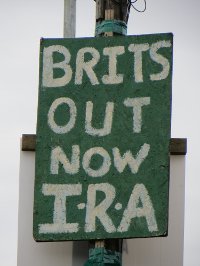
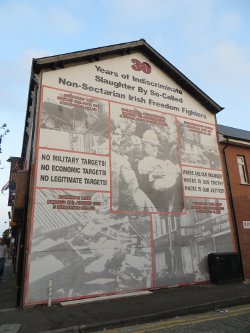
The conflict in Northern Ireland was a fight for social equality against discrimination. Many leaders and volunteers of the IRA were tortured and assassinated by the Royalist British Army. We visited West Belfast to learn about the terrible years of war and suffering. We took a guided tour with an IRA ex-political prisoner. The peace talks started in 1988 but an agreement was not sign until 1994. Tension between Protestants and Catholics still exist in Belfast today. We felt it while walking through the streets of Belfast, where the pride, loyalty, and belonging to the United Kingdom or the Republic of Ireland is displayed with flags coming out of many windows and murals painted in many corners. The city is still socially divided by areas in which Catholics and Protestants do not live together.
We also visited the city of Londonderry, or Derry as it is commonly known today to avoid conflict and susceptibility. Derry was a place of major struggle and activity from the IRA civil rights movement. Political Murals and the famous sign: “You are now in Free Derry” told us the story of a cause in which many lost their lives.
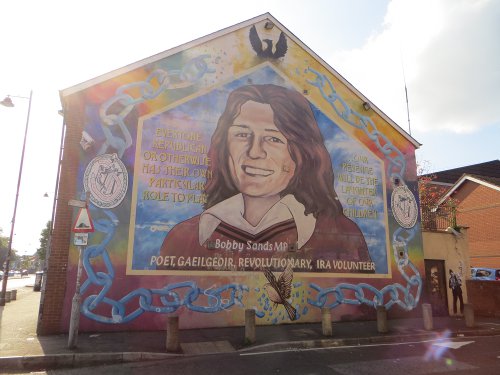
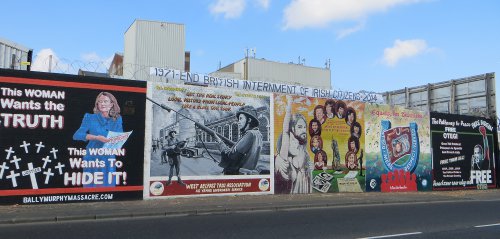
The beautiful island of Ireland is still divided: in the south the Republic of Ireland and in the north Northern Ireland, the prevailing United Kingdom. The story is tragic from whatever perspective you want to see it. The bottom line is that humans kill other humans as puppets of others who invented rules of division in favor of their greedy interest. It has never been about “God,” race, or religion. It has always been about who controls the land and its profits, that is all.
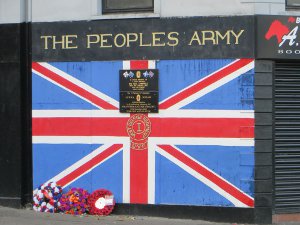
The United Kingdom and many other colonizer empires have inflicted the same abuse all over the world and have never paid or reimbursed for what they stole. Instead, many nations that overcame decades of oppression continue facing the consequences of a society based on advantages gained through violent means. Freedom seems to be coming little by little but we are still slaves of an economic system greater than us, where the same colonizer perpetrators set the rules of the game. Nonetheless, we must say, we truly admire and respect the people of Ireland for their determination to obtain their civil rights and independence, and for supporting along the way other nations that still struggle to attain their freedom.
